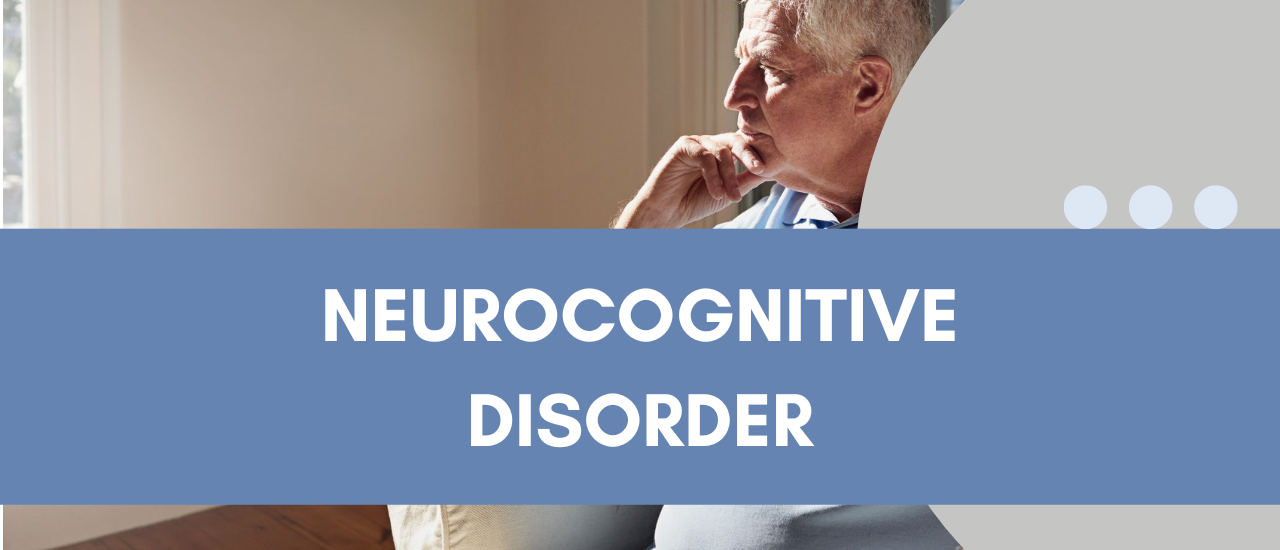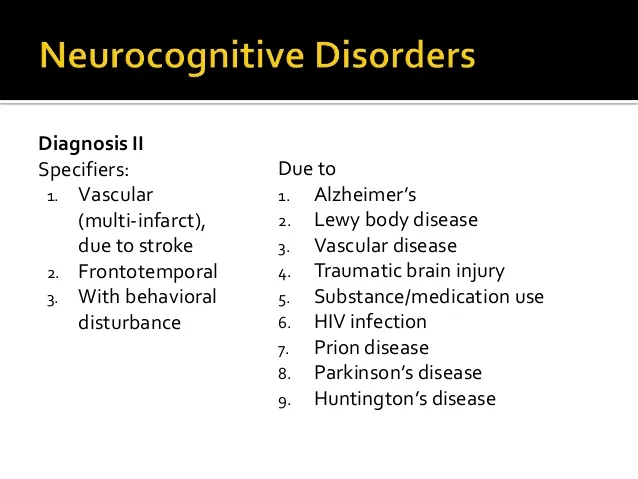


A range of illnesses known as major neurocognitive disorders, both moderate and severe, including those that were formerly all referred to as “dementia.” The conditions, which most frequently affect senior people, involve comparable cognitive decline and deficits. Declines in cognitive function in areas like attention, executive function, learning and memory, language, motor abilities, or social cognition are the main symptoms of all the disorders.
A kind of neurological condition known as neurocognitive disorder is characterized by cognitive abnormalities that are more severe than other deficiencies, such as balance problems, vision problems, etc. They typically originate from a neuro-infection, which causes brain inflammation (encephalitis), a decline in appropriate blood supply, a reduction in oxygen availability, damage, etc., and issues emerge in some brain regions leading to a loss of brain cells.
Depending on the underlying aetiology, neurocognitive disorder can have a variety of symptoms. People who have a condition brought on by a neurocognitive illness might experience:
Additional signs and symptoms of neurocognitive problems include:
An individual’s capacity to control their emotions, especially anger, can also be impacted by neurocognitive diseases, and their personalities may also change in other ways. Cooking, cleaning, or problems adhering to a medicine schedule, as well as trouble with bathing, eating, dressing, and using the restroom, are common manifestations of the impacts on a person’s capacity to follow directions and carry out complex activities.
The DSM-5 estimates that 1-2% of adults at age 65 and 30% of people at age 85 have significant neurocognitive disorders. By contrast, mild neurocognitive dysfunction affects between 5-25% of individuals by the age of 85 and between 2-10% of individuals at the age of 65.
The major neurocognitive disorder are caused by neurodegenerative illnesses. Alzheimer’s disease, Huntington’s disease, multiple sclerosis, dementia, Parkinson’s disease, and prion disease are just a few of the neurodegenerative illnesses that can result in neurocognitive impairments. However, elderly are more likely to be affected by these.
Neurocognitive problems are more likely to appear in adults under the age of 60 if they have been injured or infected. A severe injury that results in brain hemorrhage, concussion, meningitis, septicemia, encephalitis, blood clots, vitamin deficiencies, and drug or alcohol addiction are among the conditions that may cause a neurocognitive impairment.
The likelihood of acquiring a neurocognitive disease will be influenced by lifestyle choices to some extent. For instance, working in an environment where there is exposure to heavy metals, such as mercury or lead, might increase the chance of nervous system injury over time. Along with this, having a cardiovascular condition, being over 60, abusing drugs or alcohol, having diabetes, or taking part in contact sports with a higher risk of head injury may increase a person’s risk of getting a neurocognitive disease.
Different kinds of neurocognitive diseases exist. The categories of mild and major are among the main ones. Some of these conditions are.

Parkinson’s disease:
Parkinson’s is a condition of the motor system. Trembling is one of the distinguishing characteristics, notably in the hands. It may also result in behavioral changes and sadness. The person may experience speech difficulties and sleep issues in the later stages.
Huntington’s disease:
A genetic medical disorder called Huntington’s disease causes the brain’s nerve cells to gradually degenerate or break down. The quality of life is significantly impacted by Huntington’s disease, which frequently results in physical, cognitive, and psychological impairments.
Huntington’s disease symptoms and signs typically appear in people in their 30s to 40s, however the disease can manifest earlier or later in life. Juvenile Huntington’s disease is the name given to the condition when it first manifests before the age of 20.
Vascular dementia:
Memory, cognitive, and behavioral abnormalities brought on by ailments that impact the blood arteries in the brain are referred to as vascular dementia. Size, location, and number of vascular alterations can have a major impact on cognition and brain function. Recognizing various dementias spread awareness of the various varieties of dementia by sharing this info graphic.
Vascular dementia symptoms may appear suddenly or progressively develop over time, with brief periods of improvement conceivable. Vascular dementia can appear on its own or accompany another diagnosis like Alzheimer’s disease or another type of dementia.
Alzheimer’s disease:
A degenerative neurologic condition called Alzheimer’s disease results in the death of brain cells and brain shrinkage. The most frequent cause of dementia, which is characterized by a steady deterioration in mental, behavioral, and social abilities and impairs a person’s capacity for independent functioning, is Alzheimer’s disease.
In the United States, 5.8 million persons aged 65 and older have Alzheimer’s disease. Eighty percent of them are 75 or older. Between 60% and 70% of the estimated 50 million dementia sufferers globally are thought to have Alzheimer’s disease.
Lewy body disease:
Round protein clumps called Lewy bodies accumulate abnormally in the brain in a condition known as Lewy body disease, which kills nerve cells. Specific parts of the brain are affected by the Lewy bodies, which causes symptoms that have an impact on behavior, thinking, memory, and mobility.
Frontotemporal degeneration:
A variety of conditions that gradually harm the frontal and temporal lobes of the brain result in frontotemporal dementia. These harms result in modifications to thought and behavior. Unusual behaviors, emotional issues, difficulty communicating, difficulties at work, and difficulties walking are just a few symptoms. FTD, also known as frontotemporal diseases, is a rare kind of dementia that typically strikes people younger than those with other forms of dementia. 60% of those who have frontotemporal dementia are between the ages of 45 and 64.
Traumatic injury to the brain:
When the head is hit, a traumatic brain injury, or TBI, may result. The injury may be non-penetrating, like being struck in the head in a car accident, or it may be penetrating, like a gunshot wound. The degree of traumatic brain damage varies. While many TBI victims recover within a few days, more severe cases might result in death or irreversible brain damage.
Prion disease:
A broad phrase known as “prion illness” is used to describe a small range of brain abnormalities that can occur in both humans and animals. As a result, the disease has the potential to pass from animal to human and occasionally from human to human. The prion protein, which can be found in your tissues and brain, is what causes these disorders. Some scientists think that healthy prion proteins shield the brain from harm. However, prion proteins with unusual shapes are contagious and can lead to illnesses.